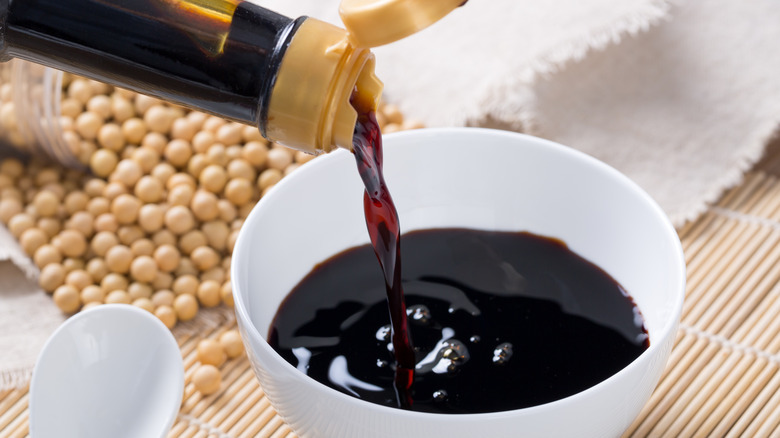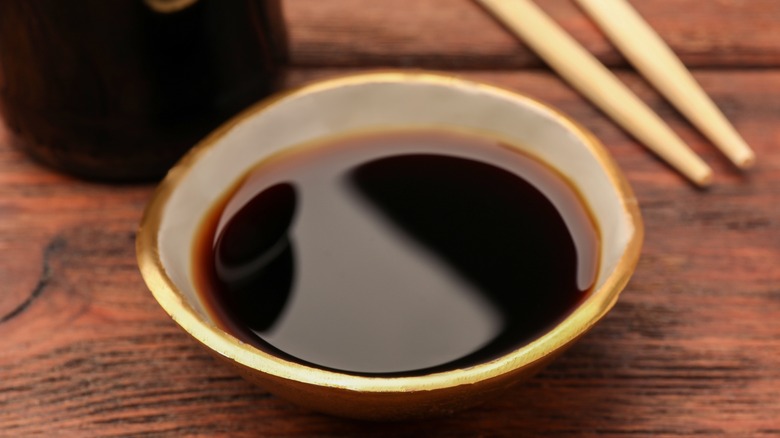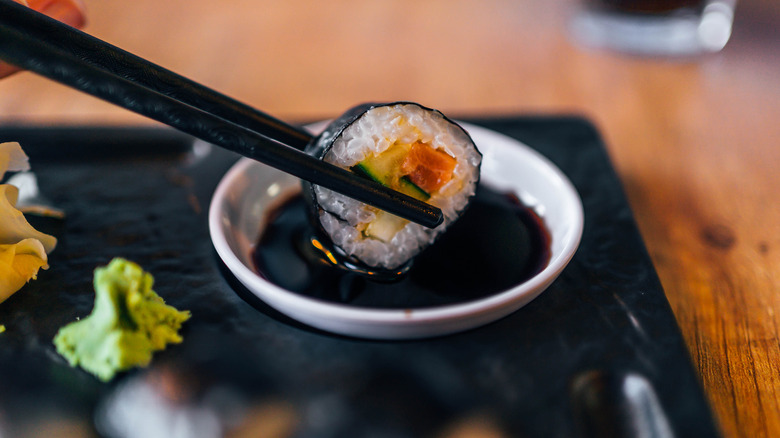Is There A Difference Between Chinese And Japanese Soy Sauce?
While some people might think that different soy sauces are simply the orange top versus the green one, that simplistic view of sodium levels may only be a little sprinkle of a flavor conversation. Before just grabbing any bottle from the shelf, appreciating the difference between Chinese and Japanese soy sauce will make a difference in every bite. While at first glance, the liquid in the bottle appears similar, the ingredients used to create the different versions develop unique flavors.
As the original version, dating back over 2,500, traditional Chinese soy sauce is primarily slightly fermented soybeans and typically has a strong and salty taste. In contrast, Japanese soy sauce combines wheat with soybeans, which are fermented longer. By adding wheat, the Japanese product tends to be slightly sweeter, thinner, and more robust.
Today, both soy sauces come in regular, light, dark, and even finishing versions as well as specialty options. Many of the grocery available store soy sauce brands are aged for around six months while other specialty offerings can be aged far longer. Similar to some wines, an aged soy sauce can be pricier than the more mass-produced variety. In addition, the longer aging creates a more robust flavor, which can be used as a finishing element versus a flavoring ingredient in a recipe.
Chinese soy sauce sizzles with rich flavor
As the liquid hits a wok, the sizzle, caramelization, and punch of flavor give any dish umami notes. Usually referred to as jiangyou or chiyou, Chinese soy sauces can be regular, light, dark, and finishing varieties. While mass-produced and artisanal offerings tend to be quite different, the inherent flavor is a reflection of the location where the soy sauce was created.
Generally, regular Chinese soy sauce is the most common variety. From a simple stir fry to a braise, the umber-colored liquid is intended to be used during cooking. As soon as the sauce hits the heat, the flavors become more pronounced as the sugars caramelize. While some cooks use soy sauce as a salty component, the slight sugary note and pungent aroma round out all the flavors in a dish.
Light soy sauce is used when the rich sepia color can muddle the appearance of a dish. Similar to a white pepper swap, its use focuses on a visual component. In contrast, dark and finishing sauces are meant to be used sparingly. The thicker, somewhat sticky, consistency denotes the extra salinity that it offers. Similar to a sprinkle of Maldon salt or a drizzle of olive oil, these items are meant to be flavor pops.
For the cook who appreciates aged balsamic vinegar or a well-sourced artisanal olive oil, appreciating the nuance of Chinese soy sauce could be another culinary trick to elevate a favorite recipe.
Japanese soy sauce is a versatile flavor booster
While diners might grab a bottle, pour the amber-colored liquid, and carefully dip sushi into that little dish, Japanese soy sauce is more than that simple condiment. Although the different brewing methods impact the final flavor, generally Japanese soy sauce tends to be thin in consistency, which leads to easy pourability.
Similar to Chinese soy sauce, the Japanese variety comes in light and dark, as well as a thicker sauce and refermented option. Generally, the light and dark versions are used in cooking. For dishes that need to retain a lighter color or prefer a slightly sweeter flavor, light soy sauce is used. Although counterintuitive of its color, light Japanese soy sauce can be saltier than the dark variety.
Dark Japanese soy sauce is the most common option. It can be used to flavor dishes like a short rib stew, hot pot, and a variety of other recipes. While it offers an umami punch, it is not necessarily overly salty. Even though it should not be poured liberally, it can be used more abundantly than other varieties. Given that versatility, Japanese soy sauce has become a popular ingredient to create flavor depth in dishes. It might be a reason why there always seems to be an open bottle in the refrigerator.
So, the next time this ingredient is needed in a recipe, think before just grabbing any bottle. The nuanced flavor differences between Chinese and Japanese soy sauce impact the eating enjoyment.


